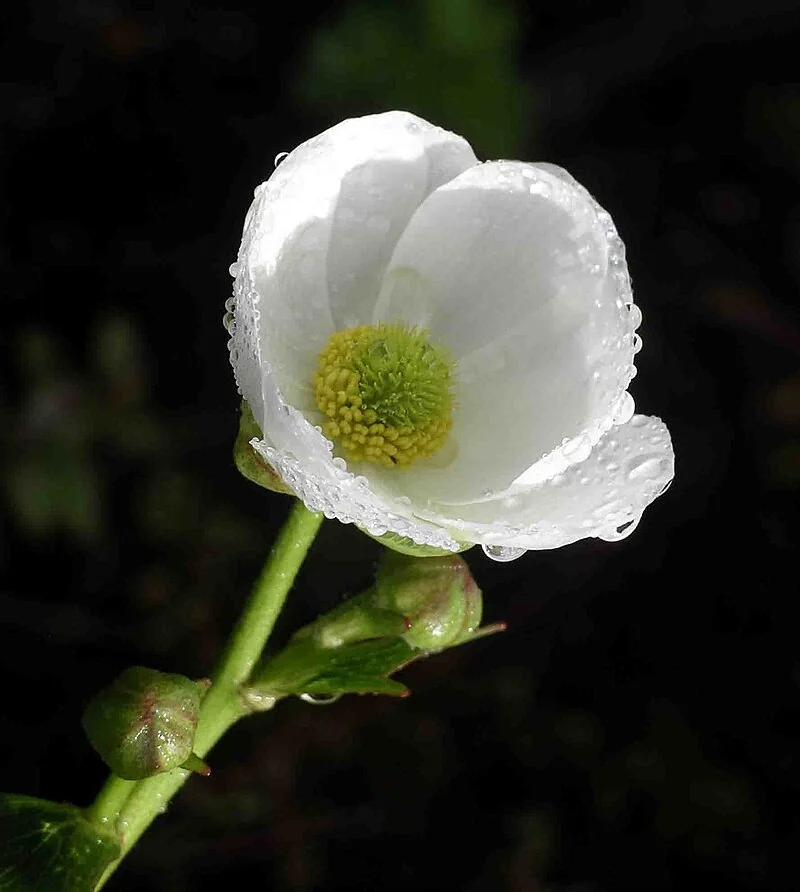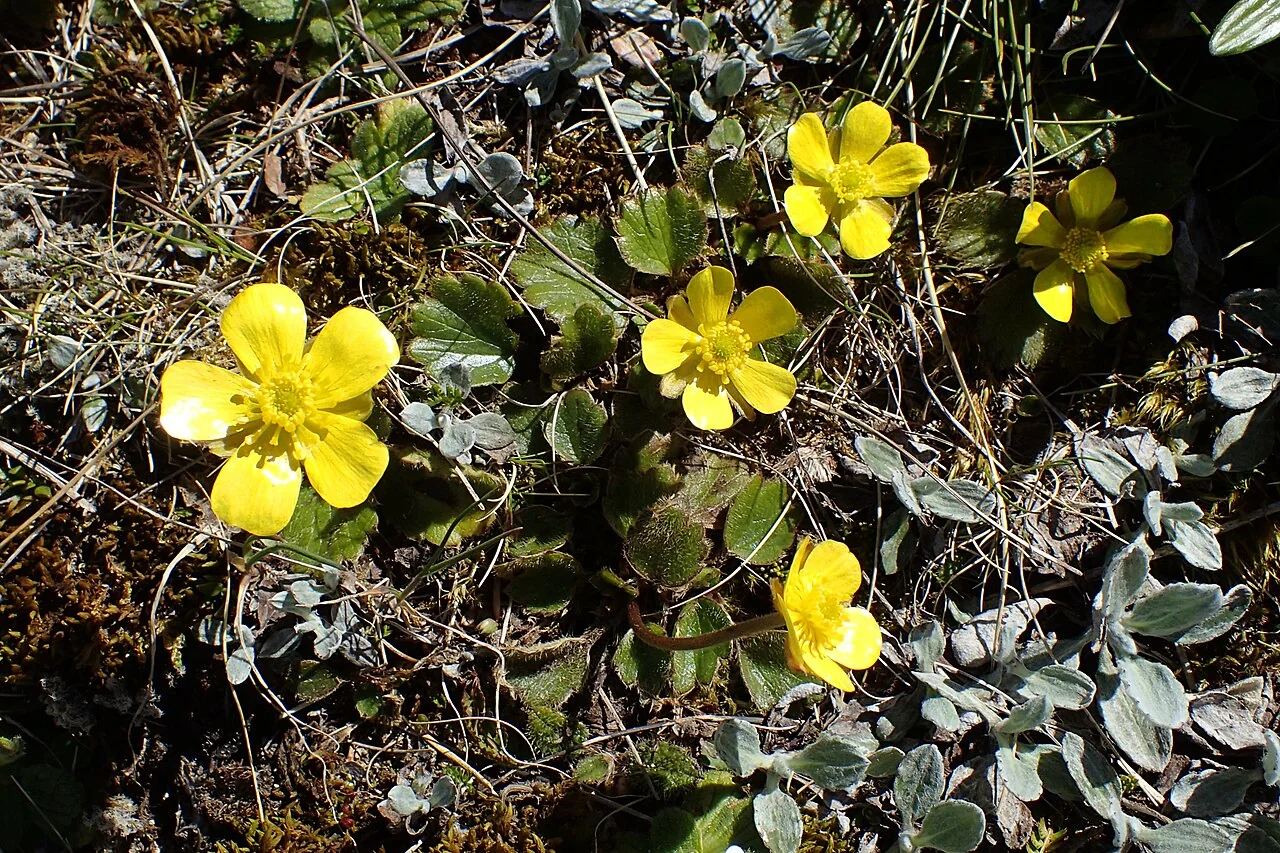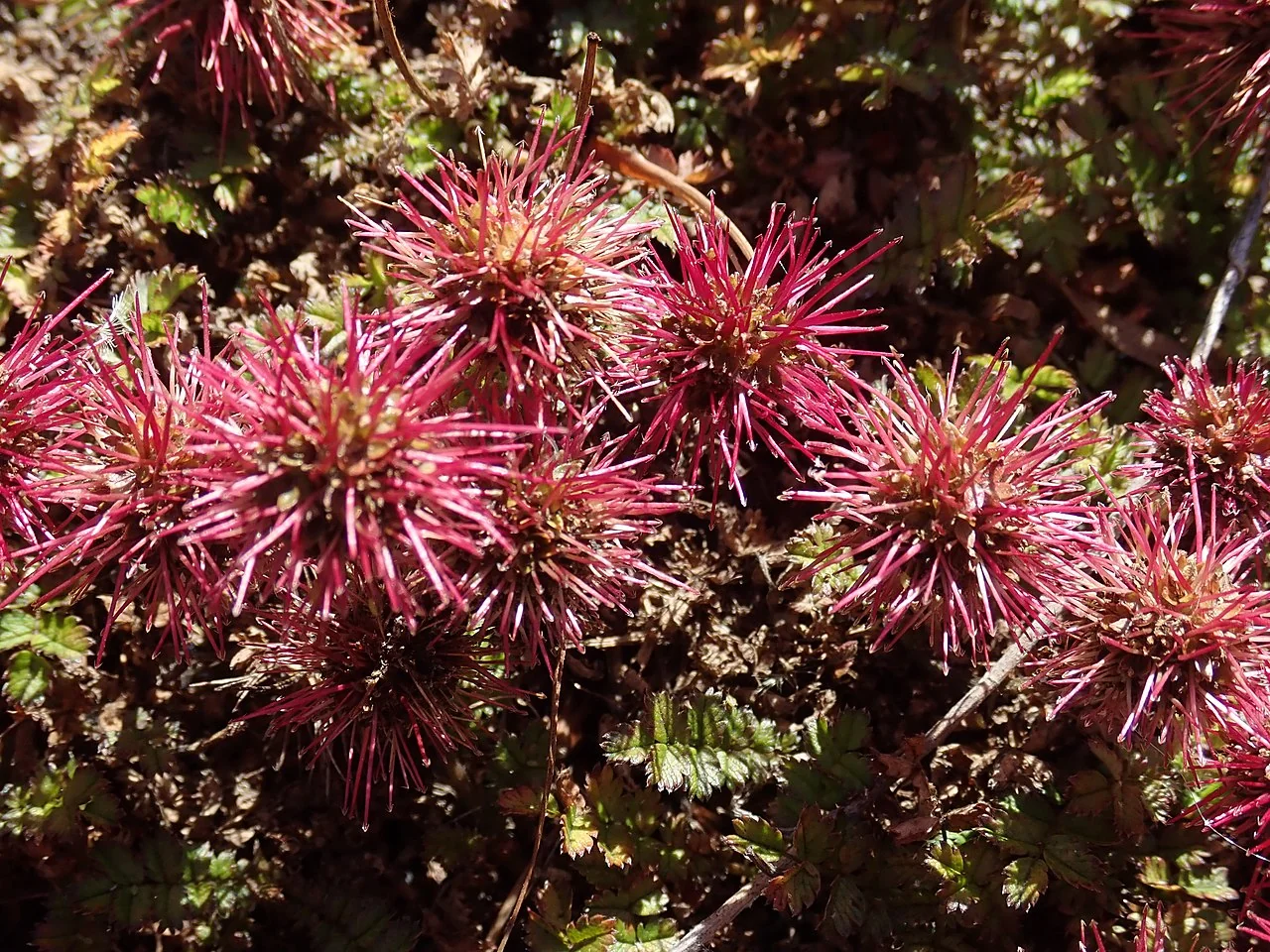
Mount Cook Buttercup
Ranunculus lyallii
Introduction
Mount Cook Lily (scientific name: Ranunculus lyallii ) is New Zealand's largest buttercup and one of the world's most spectacular alpine flowers. Despite its common name, it's not a true lily but a giant buttercup that produces magnificent white flowers with golden centers. This iconic alpine plant is found in the high mountain regions of the South Island. Explore more in the native plants index .

Plant Description
Botanical Features
Mount Cook Buttercup ( Ranunculus lyallii ), also known as the Mount Cook lily or giant buttercup, is an endemic New Zealand plant and the largest species in the genus Ranunculus. It is a robust, herbaceous perennial that can grow over a meter tall, typically ranging from 60-120 cm. The plant features large, glossy, dark green, and leathery leaves that are peltate (stalk attached to the centre of the blade) and orbicular (saucer-shaped). These leaves can be quite substantial, ranging from 15-40 cm in diameter. They are known to collect water after rainfall. It produces showy, cup-shaped white flowers, 5-8 cm in diameter, with 10-20 overlapping white petals and numerous yellow stamens surrounding a green cone-like centre. Flowering occurs from late spring to early summer, typically from October to January, with fruiting from November to March. This species is native to the South Island and Stewart Island of New Zealand, growing in sub-alpine to alpine herbfields at altitudes of 700-1,500 meters. It thrives in moist, gravelly soils, often found along stream banks and in damp locations within scrub and grasslands. It has a stout rhizome and its stems are erect, either glabrous or sparsely hairy. All parts of the plant are poisonous if ingested, and its sap may irritate the skin.
Quick Facts
Essential Information
| Scientific Name | Ranunculus Lyallii |
|---|---|
| Common Name | Mount Cook Lily, Mount Cook Buttercup, Giant Buttercup |
| Identity | World's largest buttercup, not a true lily. |
| Height | Up to 1 meter (can exceed 1 meter in flower) |
| Leaf Size | Leaves can be larger than a hand, up to 40 cm across. |
| Flower Size | 5-8 cm in diameter. |
| Appearance | Large, glossy, dark green, peltate (umbrella-shaped) leaves and showy, cup-shaped white flowers with golden centers. |
| Habitat | Endemic to New Zealand, found in sub-alpine to alpine herbfields in the South Island mountains and on Stewart Island. Typically at altitudes of 700 m to 1500 m. |
| Soil | Moist, gravelly soils, often near stream banks. |
| Cultural Significance | One of New Zealand's most well-known alpine plants, featured on postcards, stamps, and as a logo. |
| Water Needs | High; requires consistent moisture and excellent drainage |
| Light | Full sun to partial shade in alpine conditions |
| Spread | 30-60 cm |
| Frost Tolerance | Extremely hardy; alpine conditions |
| Salt Tolerance | Low; alpine species unsuited to coastal conditions |
| Growth Rate | Slow |
| Lifespan | Long-lived alpine perennial |
Climate Best Suited to
Regional climate suitability across major New Zealand cities.
Regional Suitability
| Whangārei | Ideal |
| Auckland | Ideal |
| Hamilton | Suitable |
| Rotorua | Suitable |
| Tauranga | Ideal |
| Gisborne | Ideal |
| New Plymouth | Ideal |
| Whanganui | Ideal |
| Palmerston North | Suitable |
| Napier | Ideal |
| Wellington | Ideal |
| Nelson | Ideal |
| Christchurch | Suitable |
| Dunedin | Suitable |
| Invercargill | Suitable |
| City | Climate Suitability |
|---|
Natural Habitat
Mount Cook Buttercup ( Ranunculus lyallii ), also known as the Mount Cook lily or giant buttercup, is a species of buttercup endemic to New Zealand. Its natural habitat is primarily in the subalpine to alpine herb fields of the South Island and on Stewart Island.
Key Habitats Include:
- Subalpine to Alpine Environments: This plant thrives in subalpine to alpine environments, typically found at altitudes ranging from 700 to 1,500 meters above sea level.
- Herbfields and Creek Sides: Its preferred habitats include montane and subalpine herb-fields and creek sides, favoring damp locations within scrub and grasslands.
- Specific Locations: Notable areas where it can be found include Aoraki / Mount Cook National Park and other alpine regions around Arthur's Pass.
Preferred Conditions:
- Moist, Well-Drained Soil: Ranunculus lyallii prefers cool, moist conditions with consistent moisture and well-drained soil. It is also adapted to infertile soils.
- Cold Tolerance: It is extremely hardy and well-adapted to the harsh alpine conditions, including frost and snow.
The Mount Cook Buttercup's presence in these specific high-altitude habitats underscores its ecological importance in contributing to the biodiversity and unique flora of New Zealand's mountainous regions.
Plant Conservation
Mount Cook lily ( Ranunculus lyallii ) is widely protected within New Zealand's alpine national parks and is not considered nationally threatened, but local populations are vulnerable to browsing by thar, chamois and deer, trampling around popular tracks, and competition from invasive herbs. Conservation focuses on ungulate control, careful track design and seasonal closures, and protecting seepage sites where seedlings establish. Ex situ seed banking and cultivated backup collections complement in situ management to maintain genetic diversity across its naturally patchy range.
Growing Requirements
Soil Requirements
The Mount Cook Lily demands consistently moist, very well-drained soil. It thrives in gravelly, rocky, or sandy loams rich in organic matter, mimicking its natural alpine scree and herbfield habitats. Excellent drainage is crucial to prevent root rot, especially in winter.
Light Requirements
Full sun is ideal for optimal growth and abundant flowering. However, in warmer climates or during intense summer heat, some partial shade, particularly in the afternoon, can help prevent leaf scorching and stress.
Water Requirements
Consistent moisture is essential for the Mount Cook Lily. It requires a steady supply of water, especially during its active growth and flowering periods. While it needs moist conditions, the soil must never be waterlogged. Good drainage is key to balancing moisture needs.
Planting Guide
Cool, Wet Spring - Dry Feet in Winter
The Mount Cook buttercup ( Ranunculus lyallii ) thrives in alpine conditions: cool air, bright light, plentiful spring meltwater, and fast-draining, stony soils. Avoid warm, humid sites.
Establishment
- Plant in late summer to early autumn once heat has eased.
- Use a deep, gritty mix (pumice/scoria + coarse sand) over free-draining subsoil.
- Water thoroughly in spring and early summer; keep barely moist in winter.
Top-dress with fine gravel annually to keep crowns clean and discourage rot.
Ecological Role
Alpine Pollinator Magnet
The large white-rimmed flowers of Ranunculus lyallii provide abundant pollen and nectar during a short alpine summer, supporting flies, beetles, and native solitary bees in high-country herbfields.
Scree and Snowpatch Edges
Naturally occurring on moist, stony slopes near lingering snow, plants help stabilise thin alpine soils while allowing light to reach low cushions and mosses.
Uses and Significance
An Icon of the Southern Alps
- Cultural Icon: The Mount Cook Lily is one of New Zealand's most recognizable alpine plants, serving as a powerful symbol of the country's unique natural heritage. Its image has been widely used on postcards, stamps, and even as a corporate logo, cementing its status as a national icon.
- Botanical Distinction: As the world's largest buttercup, Ranunculus lyallii is a botanical marvel. Its impressive size, with leaves up to 40 cm across and flower stalks exceeding a meter in height, makes it a standout species in the alpine flora.
- Ornamental Value: With its large, glossy, umbrella-shaped leaves and spectacular white, saucer-shaped flowers with golden centers, the Mount Cook Lily is a highly cherished ornamental plant. It is cultivated in specialized alpine gardens and by enthusiasts for its unique beauty.
- Ecological Role: In its native subalpine and alpine herbfield habitats, it plays a role in supporting local ecosystems, attracting various pollinators with its prominent flowers.
- Practical Use: The plant's large, cup-like leaves have been known to collect rainwater, which historically provided a practical water source for trampers in the alpine environment.
- Symbolism: In Māori culture, it can represent resilience and beauty, thriving in harsh alpine environments. More broadly, it symbolizes purity, new beginnings, and cleansing emotions.
Cultural Significance
Traditional Uses and Values
Ranunculus lyallii , commonly known as the Mount Cook lily (though it is actually the world's largest buttercup), holds significant cultural importance in New Zealand. It is considered one of New Zealand's most well-known alpine plants and is endemic to the country, found primarily in the South Island and on Stewart Island. Its cultural significance is highlighted in several ways: it is a prominent symbol in New Zealand, having been the emblem for Mount Cook Airlines and frequently appearing on New Zealand Post stamps. Its striking appearance, with large white flowers and glossy leaves, makes it a popular subject for postcards and photography. Despite its delicate appearance, its ability to thrive in the harsh alpine environment of the Southern Alps, enduring extreme wind and rain, contributes to its iconic status as a symbol of strength. While not as widely documented for specific traditional Māori uses as some other native plants, its presence contributes to the rich biodiversity of New Zealand's alpine regions, which are culturally significant as sources of traditional knowledge and resources. It also serves as an indicator species for healthy alpine ecosystems.
Landscaping Ideas
Alpine Showcase
Grow Mount Cook buttercup in raised, sharply drained scree beds with cool air flow. Pair with Celmisia , Raoulia , and dwarf Chionochloa to evoke high-country herbfields.
Seasonal Care
The Mount Cook Lily ( Ranunculus lyallii ) is an alpine plant that requires specific care to thrive, particularly due to its sensitivity to extreme temperatures and its need for consistent moisture with excellent drainage. Understanding its seasonal needs is crucial for successful cultivation.
Spring
- New Growth: As winter snows melt and temperatures rise, new leaves and flower stalks will emerge.
- Watering: Maintain consistent moisture in the soil, ensuring it is well-drained. Water regularly as the plant enters its active growth phase.
- Fertilizing: Apply a diluted, balanced fertilizer in early spring to support new growth. Avoid high-nitrogen fertilizers.
- Pruning: Remove any dead or damaged foliage from the previous season to encourage fresh growth and improve air circulation.
- Transplanting: Spring, as the soil warms, is the best time to transplant if necessary.
Summer
- Flowering: The spectacular white flowers typically appear in summer.
- Watering: Continue to provide consistent moisture, especially during dry spells. However, protect from intense afternoon sun and strong winds, which can lead to leaf scorching and rapid soil drying.
- Dormancy: In very hot summer temperatures, the plant may go dormant. Ensure adequate moisture but avoid overwatering during this period.
Autumn
- Seed Collection: If propagating from seed, collect ripe seeds after flowering.
- Pruning: After flowering, deadhead spent blooms to maintain aesthetics and prevent unwanted seeding.
- Winter Preparation: In colder areas, apply a mulch of straw or pine needles around the base to protect the plant from winter injury.
Winter
- Temperature: The Mount Cook Lily is not resistant to severe cold, and temperatures should ideally not drop below 0°C. Protect from harsh frosts.
- Watering: If the plant is dormant (only the bulb is present), water sparingly, allowing the soil to dry out more between waterings.
- Protection: Ensure adequate mulching in cold regions.
Pruning
Techniques and Timing
The Mount Cook Lily ( Ranunculus lyallii ) generally requires minimal pruning, primarily focused on maintaining plant health and aesthetics. Its natural growth habit is best preserved, with interventions limited to removing spent or damaged parts.
- Deadheading: After the flowers fade, deadhead spent blooms to maintain a tidy appearance and prevent the plant from expending energy on seed production, unless seed collection is desired.
- Foliage Removal: In early to late spring, remove any dead, yellowing, or damaged foliage from the previous season. Cut these back to the base of the plant using clean, sharp tools. This encourages fresh growth and improves air circulation.
- Avoid Excessive Pruning: Do not remove healthy leaves or stems unnecessarily, as this can stress the plant and reduce its vigor. The large leaves are crucial for photosynthesis and energy storage.
- Timing: The best time for any pruning is typically in spring, as the plant emerges from dormancy and begins its active growth cycle.
How to Grow Mount Cook Buttercup
Mount Cook Buttercup ( Ranunculus lyallii ), also known as the Mount Cook Lily, is New Zealand's largest buttercup and one of the world's most spectacular alpine flowers. This iconic alpine plant is found in the high mountain regions of the South Island, where it produces magnificent white flowers with golden centers. Its impressive size, with leaves up to 40 cm across and flower stalks exceeding a meter in height, makes it a botanical marvel. While challenging to cultivate outside its native alpine environment, understanding its propagation methods is crucial for those dedicated to growing this magnificent species.
From Seed
Propagating Mount Cook Buttercup from seed can be challenging and requires significant patience, as germination is often slow and erratic. Seeds can be sown in spring or autumn in a quality seed-raising mix, lightly covered. It is crucial that the seeds undergo a prolonged cool period (cold stratification) of several months to break dormancy and encourage germination, which typically occurs the following spring. During summer, keep pots in a shaded spot with slightly moist soil, and in winter, maintain a cool, frost-free environment (ideally 5°C to 10°C). Consistent moisture and good air circulation are vital throughout the germination and early growth phases. Due to the specific requirements and slow germination, this method is often best suited for experienced propagators or specialized nurseries.
From Corms
Propagation from corms can lead to earlier flowering than from seed and is a more direct method for establishing new plants. Carefully separate corms from mature plants, ideally in late autumn or early spring. Soak the corms in water for 12 hours before planting to rehydrate them. Plant corms 10-15 cm apart and 5 cm deep with the "claws" (rooting points) facing downwards into a well-drained, humus-rich soil mix. The ideal planting temperature is 10-15°C, with new growth expected in about two weeks. Ensure consistent moisture without waterlogging, and provide protection from extreme temperatures during establishment. This method is generally more successful for home gardeners looking to expand their collection.
From Stem Cuttings
While less common and often with variable success rates, stem cuttings can be attempted from vigorous, non-flowering shoots. Take clean cuts from healthy stems, ideally in late spring or early summer. Allow the cut surfaces to callous slightly for a day or two before planting. Insert the cuttings into a moist, well-drained rooting medium, such as a mix of perlite and peat. Provide consistent moisture without saturating the soil to encourage root development, and maintain high humidity around the cuttings, perhaps using a plastic dome or a propagator. Keep in bright, indirect light. Rooting can be slow and unpredictable, making this method less reliable than seed or corm propagation for most growers.
Pests and Diseases
Resilience in the Alpine Environment
The Mount Cook Lily ( Ranunculus lyallii ) is generally robust in its native alpine environment, but certain factors can affect its health. It's important to distinguish its specific vulnerabilities from those of other lily species.
- Grazing Animals: The primary threat to wild populations of Mount Cook Lilies comes from grazing animals such as deer, chamois, and Himalayan tahr, which can significantly reduce their numbers by feeding on the plants.
- Root Rot: While the plant requires consistent moisture, it is highly susceptible to root rot if the soil is poorly drained or compacted, leading to waterlogging. Ensuring excellent drainage is crucial for preventing this issue.
- Fungal Issues: Good air circulation, promoted by appropriate spacing and occasional removal of dead foliage, helps to reduce the risk of fungal diseases.
- General Pests: Specific insect pests are not widely documented as major threats to the Mount Cook Lily. However, maintaining overall plant health through optimal growing conditions is the best defense against any opportunistic pests.
Bonus Tip
Expert Growing Advice
Protect crowns from winter wet: plant on a slight mound with a gritty top-dress, and water heavily only in spring and early summer to mimic snowmelt. Avoid overhead irrigation during humid heat.







